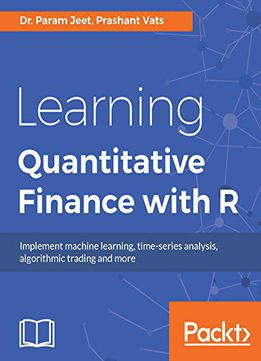
Learning Quantitative Finance With R
by Param Jeet /
2017 / English / AZW3
7.2 MB Download
Key Features
Understand the basics of R and how they can be applied in various Quantitative Finance scenarios
Learn various algorithmic trading techniques and ways to optimize them using the tools available in R.
Contain different methods to manage risk and explore trading using Machine Learning.
Book Description
The role of a quantitative analyst is very challenging, yet lucrative, so there is a lot of competition for the role in top-tier organizations and investment banks. This book is your go-to resource if you want to equip yourself with the skills required to tackle any real-world problem in quantitative finance using the popular R programming language.
You'll start by getting an understanding of the basics of R and its relevance in the field of quantitative finance. Once you've built this foundation, we'll dive into the practicalities of building financial models in R. This will help you have a fair understanding of the topics as well as their implementation, as the authors have presented some use cases along with examples that are easy to understand and correlate.
We'll also look at risk management and optimization techniques for algorithmic trading. Finally, the book will explain some advanced concepts, such as trading using machine learning, optimizations, exotic options, and hedging.
By the end of this book, you will have a firm grasp of the techniques required to implement basic quantitative finance models in R.
What you will learn
Get to know the basics of R and how to use it in the field of Quantitative Finance
Understand data processing and model building using R
Explore different types of analytical techniques such as statistical analysis, time-series analysis, predictive modeling, and econometric analysis
Build and analyze quantitative finance models using real-world examples
How real-life examples should be used to develop strategies
Performance metrics to look into before deciding upon any model
Deep dive into the vast world of machine-learning based trading
Get to grips with algorithmic trading and different ways of optimizing it
Learn about controlling risk parameters of financial instruments
About the Author
Dr. Param Jeet is a Ph.D. in mathematics from one of India's leading technological institute in Madras (IITM), India. Dr. Param Jeet has a couple of mathematical research papers published in various international journals. Dr. Param Jeet has been into the analytics industry for the last few years and has worked with various leading multinational companies as well as consulted few of companies as a data scientist.
Prashant Vats is a masters in mathematics from one of India's leading technological institute, IIT Mumbai. Prashant has been into analytics industry for more than 10 years and has worked with various leading multinational companies as well as consulted few of companies as data scientist across several domain.
Table of Contents
Introduction to R
Statistical Modeling
Econometric and Wavelet Analysis
Time Series Modeling
Algorithmic Trading
Trading Using Machine Learning
Risk Management
Optimization
Derivative Pricing











